The Tribal Tattoos of the Pacific: Emblems of Culture and Belonging
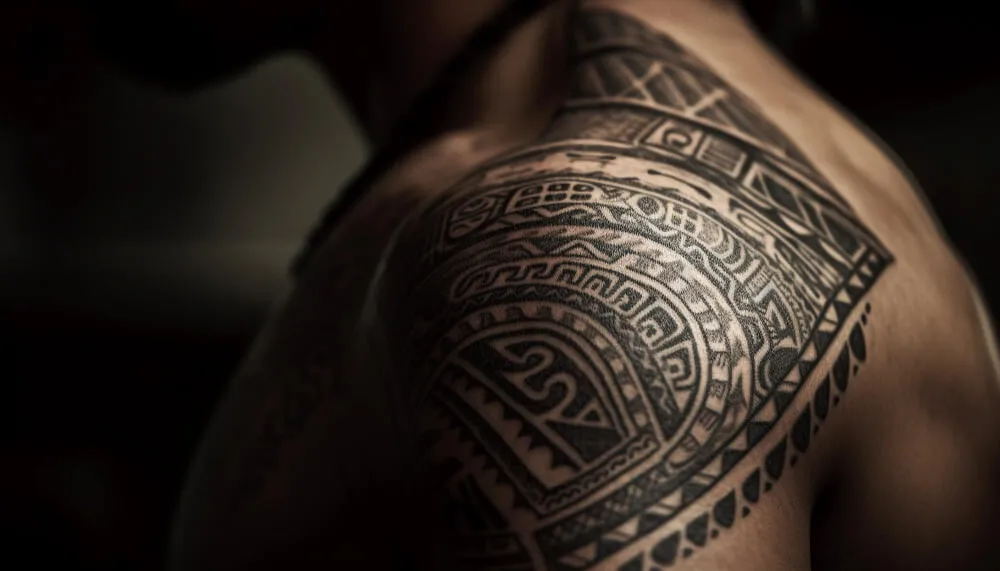
Updated On: April 23, 2024 by Yasmin Elwan
Tribal tattoos of the Pacific carry a profound cultural essence, serving as living forms of identity and testimony to a rich history of tradition and storytelling. Each mark and pattern etched onto the skin represents a narrative of individual lives, community ties, and social status within the various cultures of Polynesia. Acknowledged as one of the most intricate and meaningful tattoo traditions in the world, these tattoos offer more than aesthetics; they are a language of symbols and motifs passed down through generations.
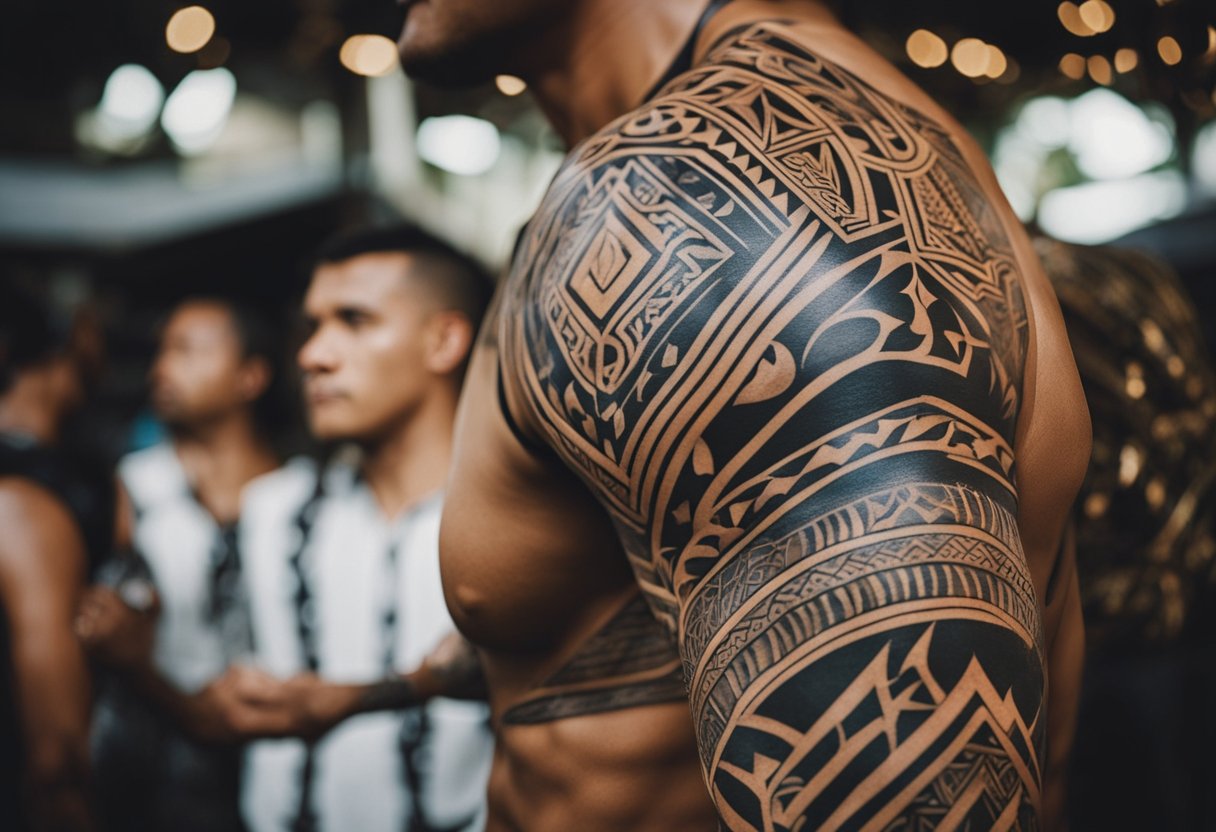
The art of Pacific tattooing has withstood the challenges of time, surviving efforts to suppress it and evolving in the modern era while still honouring the ancestral wisdom it embodies. While techniques and materials have developed, the essence of the practice preserves the spiritual and societal importance attributed to it. From the powerful imagery to the deliberate placement of each tattoo, the traditions are paramount in connecting individuals to their cultural identity.
History and Origins
In delving into the rich tapestry of Polynesian tribal tattoos, it is essential to understand their roots and the paths they traversed across the Pacific. These tattoos are a testament to the intricate history and profound cultural significance ingrained in the identity of Polynesian peoples.
Emergence in Polynesia
The tradition of inking the skin in Polynesia is ancient and believed to be over two thousand years old. Within Polynesian culture, the traditional tattoo, or ‘ta moko’, is far more than an aesthetic embellishment. It embodies one’s social status, identity, and ancestry. Tattoos in this region serve as a living narrative, with each etched symbol unveiling a piece of the individual’s life and the broader Polynesian history. The motifs and designs are unique to each Polynesian island, often derived from the natural environment and spiritual beliefs, a craft handed down through generations.
Spread to the Pacific
As Polynesians voyaged across the oceans, they carried their tattooing practices to the far reaches of the Pacific. The artistry and symbolism of their tattoos influenced the surrounding regions, embedding themselves within the local traditions of other Pacific islands. This diffusion led to a diverse spectrum of styles under the umbrella of Pacific tribal tattoos, each infused with the respective island’s own cultural threads. The practice echoes the interconnectedness of the Pacific island communities, despite the vast waters that separate them.
Cultural Significance
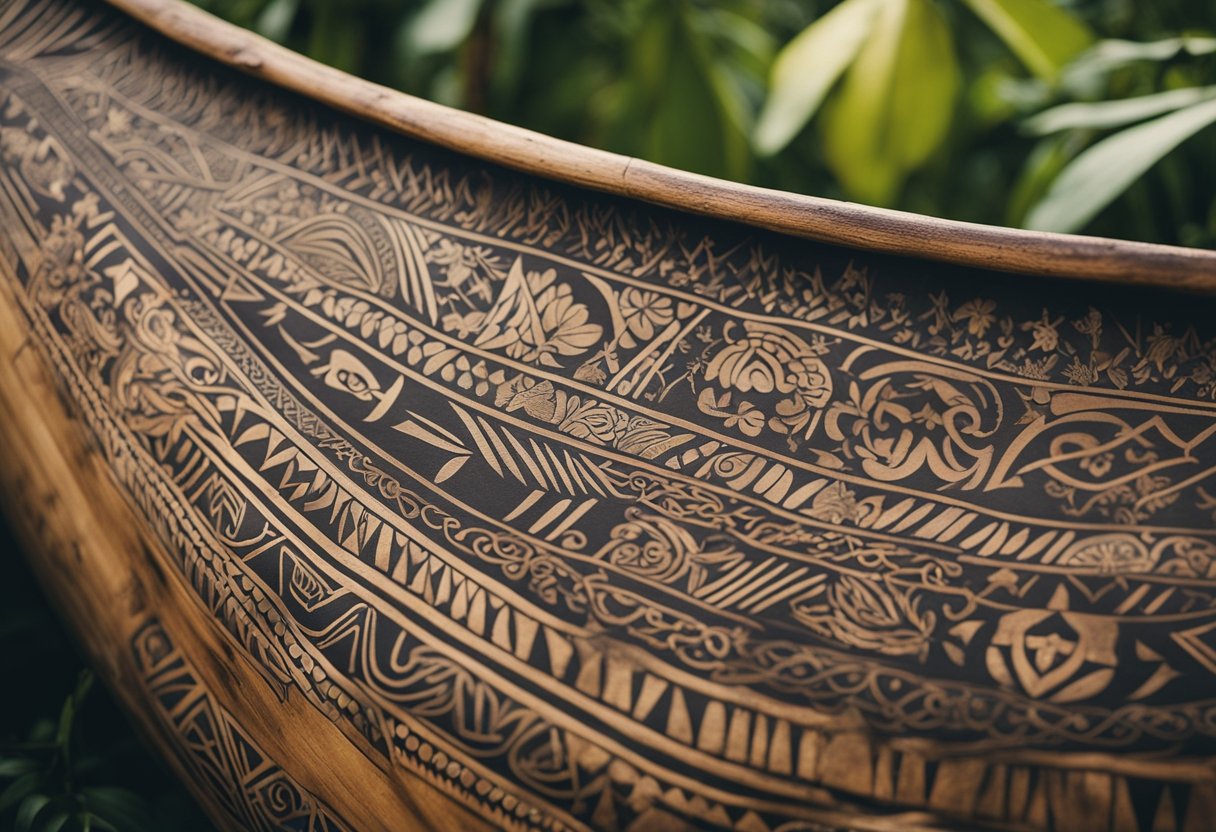
Tribal tattoos in the Pacific are not mere decorations; they are deeply embedded within the culture and social structures of indigenous peoples. These tattoos often symbolise an individual’s status, identity, mana, and the community they belong to, serving both aesthetic and communicative purposes within society.
Symbols of Status and Identity
Each tattoo carries a weight of significance, signifying the wearer’s place within the hierarchy and their lineage. In many Pacific communities, the intricate patterns inked onto the skin represent one’s genealogy and affiliation to certain familial lines. The designs are not randomly chosen; they articulate the wearer’s history, achievements, and the roles they play within the society. Bold motifs may denote leadership or a warrior’s strength, whereas other symbols might convey a person’s skill or their role as a caregiver or provider within the community.
Rites of Passage and Adulthood
Indigenous Pacific cultures often associate the receiving of tattoos with rites of passage. This transition into adulthood is marked by enduring pain, demonstrating one’s courage and readiness to take on adult responsibilities. Passing through this threshold bestows a sense of belonging and acceptance within the community. Furthermore, it reaffirms the individual’s connection to their culture and the perpetuation of traditions that have been maintained for generations. These rites uphold the social structures and imbue the participants with mana—a spiritual energy or life force considered vital in Polynesian culture.
Tattooing Techniques and Materials
In exploring the rich tradition of tattooing among Pacific cultures, we take a close look at how these meaningful marks are made, from the time-honoured methods to the adaptation of modern tools.
Traditional Methods
In the Pacific, the art of tattooing, or tatau, is steeped in heritage and reflects a deep-seated cultural significance. Traditionally, these tattoos were crafted using handmade tools fashioned from natural materials. A common technique involved tapping into the skin with implements made from wood, sometimes a sharp tooth or bone, with needles bound to a wooden handle. This method, known for its precision and the unique texture it imparts to the design, was often a communal and ceremonial act, signifying major life events.
The Maori moko, a distinctive form of tattooing from New Zealand, is a poignant example. It reflects not only social status and identity but also a person’s ancestry. The process was simultaneously a rite of passage, demanding endurance to withstand the considerable pain associated with the repetitive chiselling motions.
Introduction of Modern Tools
The arrival of Europeans introduced new tools and techniques to the Pacific. With these, the traditional materials began to give way to the use of metal needles and machines that could puncture the skin rapidly, streamlining the tattooing process. The mechanised tools provided a less painful experience and allowed for greater detail in the tattoo designs.
Nowadays, while some artists have embraced these technological advancements, others continue to honour the ancestral methods, preserving the cultural legacy of Pacific tattooing. It’s a balance of preserving the past while navigating the newer methods available. Whether by traditional hand-tapping methods or with the precision of modern machines, the spirit of tatau endures.
Designs and Patterns
In Pacific tribal tattoos, each curve and line is laden with history and significance. These designs are more than adornments; they’re a visual language of identity and status.
Meaning Behind Tribal Patterns
Tribal tattoos are a tapestry of symbols, each with a distinct meaning. For instance, ocean waves represent the adaptability and fluid nature of life, while shark teeth may denote protection and strength. The beauty of these tattoos lies in their ability to tell a person’s story through a unique combination of these elements, intricately crafted to mark important life events or achievements.
Evolution of Tattoo Designs
Over time, tattoo designs within Pacific tribal communities have undergone a transformation. While maintaining the core aspects of their traditional patterns, some artists have started to infuse contemporary influences into their work. Despite this evolution, the essence of tribal tattoos remains rooted in the ancestral and spiritual connection to the wearer’s identity. They are a living canvas, displaying a unique blend of past and present in their patterns.
Tattoo Placement and Its Meanings
In the Pacific, tribal tattoos are not just decorative. They act as indicators of a person’s identity, conveying their rank, social status, and personal achievements. The placement of these tattoos is intimately tied to their significance, with each position on the body representing different aspects of a person’s life story and societal role.
Facial and Body Tattoos
Facial tattoos, or moko, are rich in cultural significance among Polynesian societies. In Maori culture, for instance, the face can narrate an individual’s lineage, tribal affiliations, and social standing. Often, these facial tattoos indicate a rite of passage, marking the transition into adulthood and conveying a person’s role and status within the tribe.
Body tattoos in the Pacific are also deeply symbolic. The malu, for example, is a thigh tattoo traditionally worn by Samoan women, representative of cultural commitment and service. For men, the pe’a, which covers the body from waist to knees, signifies courage and is associated with notions of virility and respect.
Significance of Placement
Placement of tattoos within Polynesian culture is a deliberate choice that reflects one’s personal journey and the traits they wish to express or embody. Tattoos on the hands and feet may symbolise action and direction in life. In contrast, tattoos placed on the chest or heart area often symbolise love, loyalty, or bravery.
The significance of placement extends to the idea of protection. By marking the skin with patterns and symbols that are believed to have protective powers, individuals carry with them a permanent safeguard against ill will or misfortune. Tattoos are considered a visual expression of one’s personal history and intentions—a way to wear one’s life experiences for the world to see.
Influence on Modern Tattooing
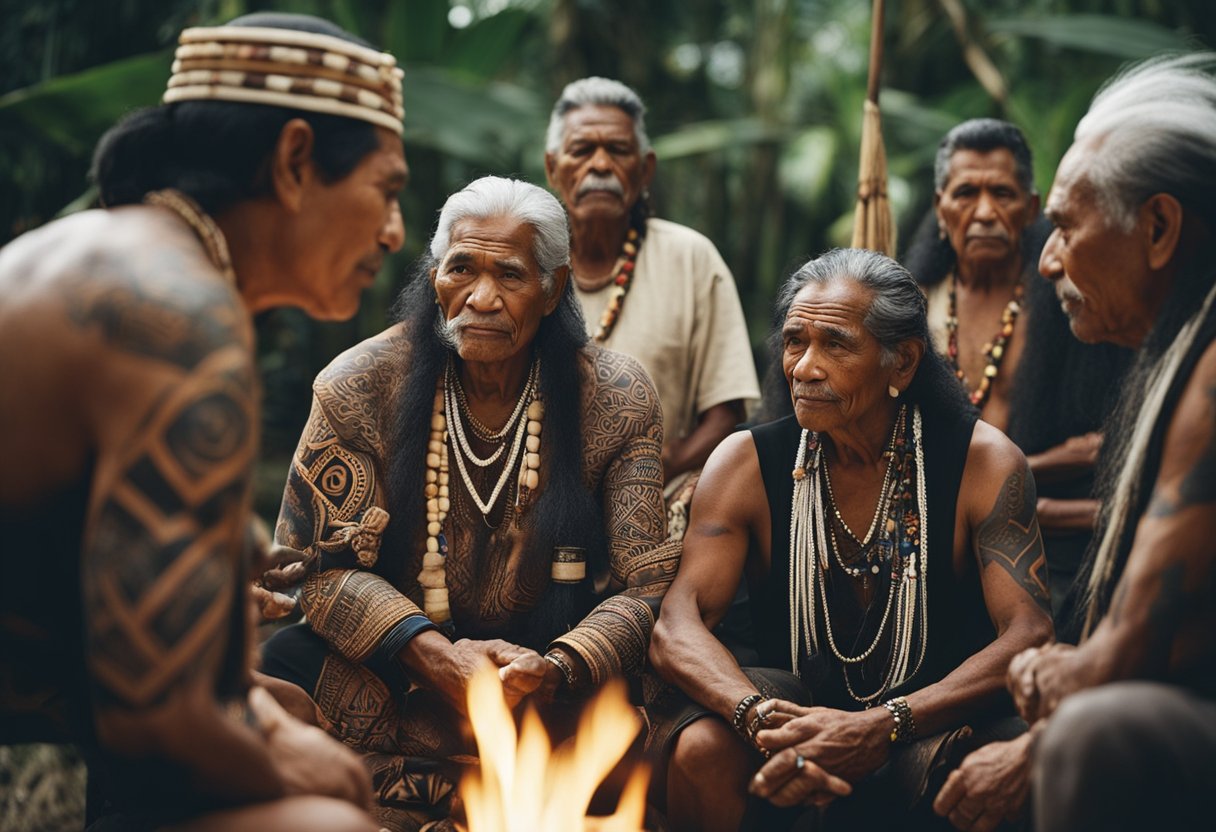
The Pacific’s tribal tattoos have not only persisted through time but have significantly influenced modern tattooing. We see this impact predominantly in the rise of contemporary tribal designs and their cross-cultural adoption.
Contemporary Tribal Designs
Polynesian tattoo motifs have been intricately woven into modern tattooing as a mainstay. Today, artists often incorporate elements from this traditional style to create bold and graphic pieces that honour the aesthetic of tribal style tattoos. The adaptation of these designs has led to the development of distinct different styles within the genre of modern tribal tattoos. Polynesian patterns can often be seen in large-scale pieces that respect their origins by maintaining the integrity of the symbolism and layout traditional to this art form.
Cross-Cultural Adoption
With the rise of global fashion, tribal tattoos have found their way into the broader cultural conversation, occasionally touching the sensitive subject of cultural appropriation. We acknowledge the importance of understanding the deep cultural meanings behind these designs before integrating them into one’s personal expression. Fashion has a tendency to blur the lines, fostering a blend of different styles, but it’s crucial to approach the adoption of such significant cultural symbols with respect and sensitivity. We strive to educate and inform about the importance of context and the stories behind tribal tattoos to promote appreciation rather than appropriation.
Tattoo Artists and Technique
The intricate designs of Pacific tribal tattoos are not only a testament to the region’s rich heritage but also to the skill and dedication of the artists behind each piece. Techniques preserved for generations highlight the crucial roles these master craftsmen play in their communities.
The Role of Skilled Artists
Tattoo artists or tufuga ta tatau in Samoa, hold a revered position within Pacific societies. Their skills are often passed down through family lines, where secrets of the craft are closely guarded. Skilled artists are responsible for more than just the application of the tattoo; they are also keepers of traditions, often holding knowledge of the symbology and history behind the designs. It is an honour to be tattooed by such artists, who select designs that reflect the wearer’s identity, social status, and achievements.
By obtaining a tattoo from a master artist, individuals are not only adorned with a mark of beauty but are also indelibly linked to the history and values of their culture. These markings can often tell a person’s life story, their family ties, and their position within the social hierarchy.
Preservation of Traditional Art
Preservation of traditional art forms is vital in keeping the culture alive. Techniques such as ‘hand-tapping’, where artists use tools made from bone, tusk, or wood, are being maintained and taught to ensure the survival of this ancient art form. Through the efforts of tatu practitioners like Keone Nunes, the ancient Polynesian practice of tattooing is experiencing a renaissance, making it possible for younger generations to appreciate and continue their ancestral traditions.
Our connection to these practices enables us to appreciate the depth and significance behind each pattern, imbuing a greater respect for the cultural narratives embedded within the skin. As guardians of this traditional art, it is our duty to support and celebrate those who endeavour to keep this heritage visible and vibrant for the world to see. Through their painstaking work, tattoo artists ensure that their craft remains esteemed and influential, securing its place as a critical medium of cultural expression.
Cultural Identity and Representation
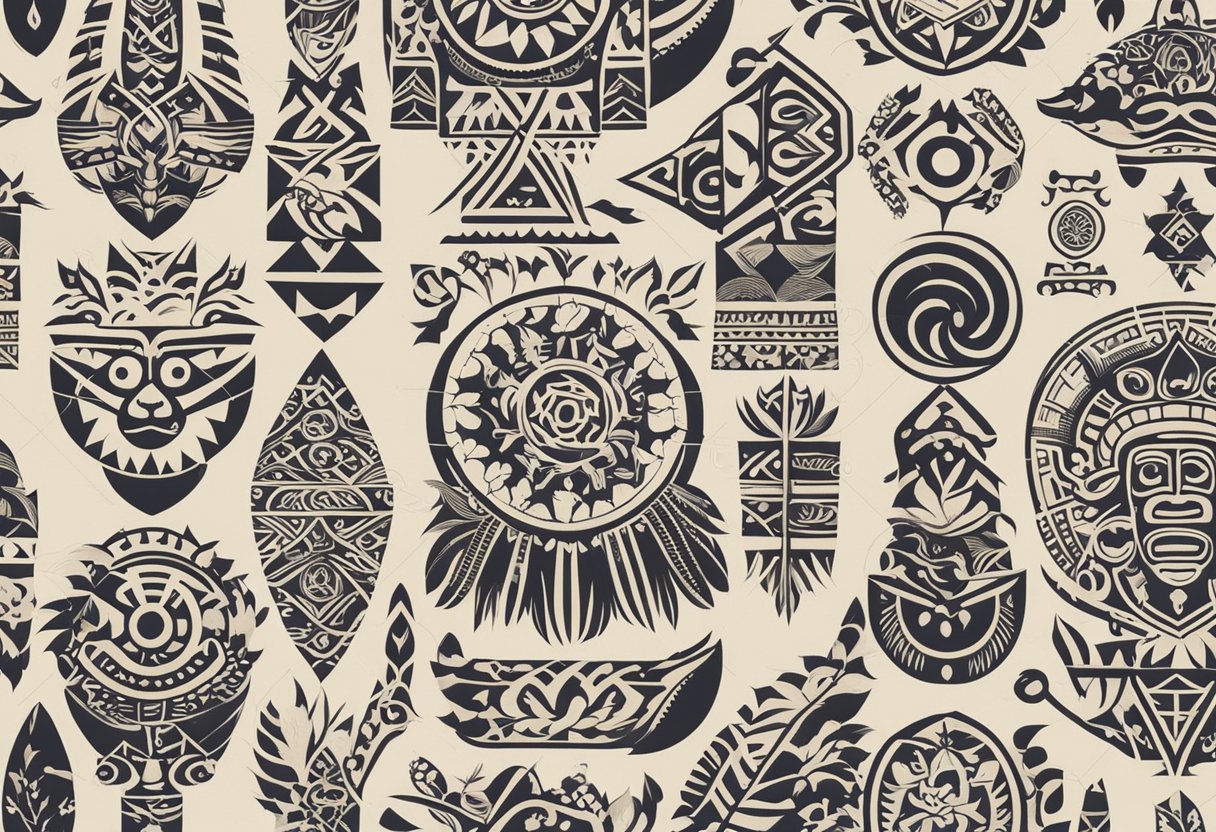
Tattooing in the Pacific is a profound expression of identity and cultural narrative. Prior to delving into specific aspects, it is essential to recognise that these tattoos are far more than mere decorations; they are a canvas of cultural significance and personal history.
Tattoos as Cultural Narratives
Tattoos within Polynesian culture serve as a visual representation of one’s lineage, social status, and personal achievements. These intricate patterns are laden with symbols that narrate stories of the wearer’s heritage and identity. The tradition of receiving tattoos can mark significant milestones and personal rites of passage, as in the case of Maori tattooing, or ta moko, which intricately links individuals to their ancestral roots.
Challenges of Cultural Appropriation
While cultural appreciation promotes understanding and respect, the line can blur into cultural appropriation. For Pacific societies, the misappropriation and commodification of traditional tattoos by outsiders pose a significant concern. Too often, the sacred symbolism of these tattoos is overlooked when non-Polynesians adopt these designs without comprehending their profound cultural implications. The issue of cultural appropriation is particularly pressing when the visual markers of identity become reduced to fashion statements, detached from their rich historical context.
Significant Regional Styles
In the vast Pacific Ocean, various island cultures have developed tattoo traditions with unique designs and meanings. These tattoos not only signify social status and identity but also connect individuals to their history and community.
Maori and Samoan Traditions
Maori Tattoos (Ta Moko): Distinctive for their intricate spiral patterns and bold, black lines, Maori tattoos are carved into the skin using chisels. This form of body art is called “Ta Moko,” and it’s a rite of passage, marking major life achievements and representing the wearer’s family heritage and social status.
- Facial Ta Moko: Facial tattoos, particularly for men, cover the entire face and are a symbol of rank, social status, and prestige.
- Moko Kauae: For Maori women, the “moko kauae,” or chin tattoo, is of great significance as it carries the family’s lineage and tribal affiliations.
Samoan Tattoos (Tatau): In Samoa, tattooing has a historical significance, where special patterns are used for chiefs and ranking members of society, and other designs mark passages of life.
Hawaiian and Marquesan Tattoos
Hawaiian Tribal Tattoos: The people of Hawaii use tattoos as a means to protect their health and spiritual well-being. Using symmetric designs and geometric patterns, these tattoos often represent island flora and fauna, recount personal stories, and indicate the wearer’s status within the community.
- Kakau: Traditional Hawaiian tattooing, known as “kakau,” involves tapping ink into the skin with tools made from bird beaks, bones, or claws.
Marquesan Tattoos: Originating from the Marquesas Islands, Marquesan tattoos are some of the most intricate in Polynesia. Common elements in these tattoos include geometric patterns and stylized motifs that represent warriors, animals, or tribal affiliations.
Our understanding of these significant regional styles allows us to appreciate how the art of tattooing in the Pacific serves not just as adornment but as a profound expression of identity and lineage.
Tattoos in Society
The role of tattoos within the Pacific societies is profound, reflecting a myriad of social nuances ranging from status to personal identity. Tribal tattoos serve as a canvas showcasing a person’s history, beliefs, and position within their community.
Acceptance of Tribal Tattoos
Tribal tattoos in the Pacific have traditionally been a widespread practice, deeply embedded within the fabric of society. For both men and women, these tattoos often denote status and identity, as well as membership in a particular community. Over time, these practices have adapted, with the art form now being viewed as a fashion statement and a means of expressing personal and cultural values in wider society.
Tattoos and Social Identity
Within Pacific cultures, tattoos are a vehicle for expressing values and a sense of belonging. For women, tattoos can signify maturity and beauty, while for men, they often chronicle achievements, rank, and warrior status. The intricate designs encapsulate individual stories and societal roles, solidifying personal identity and commanding respect within the community. This traditional art continues to influence modern fashion and is revered for its cultural significance and aesthetic appeal.
Preservation of Tribal Tattoo Practices
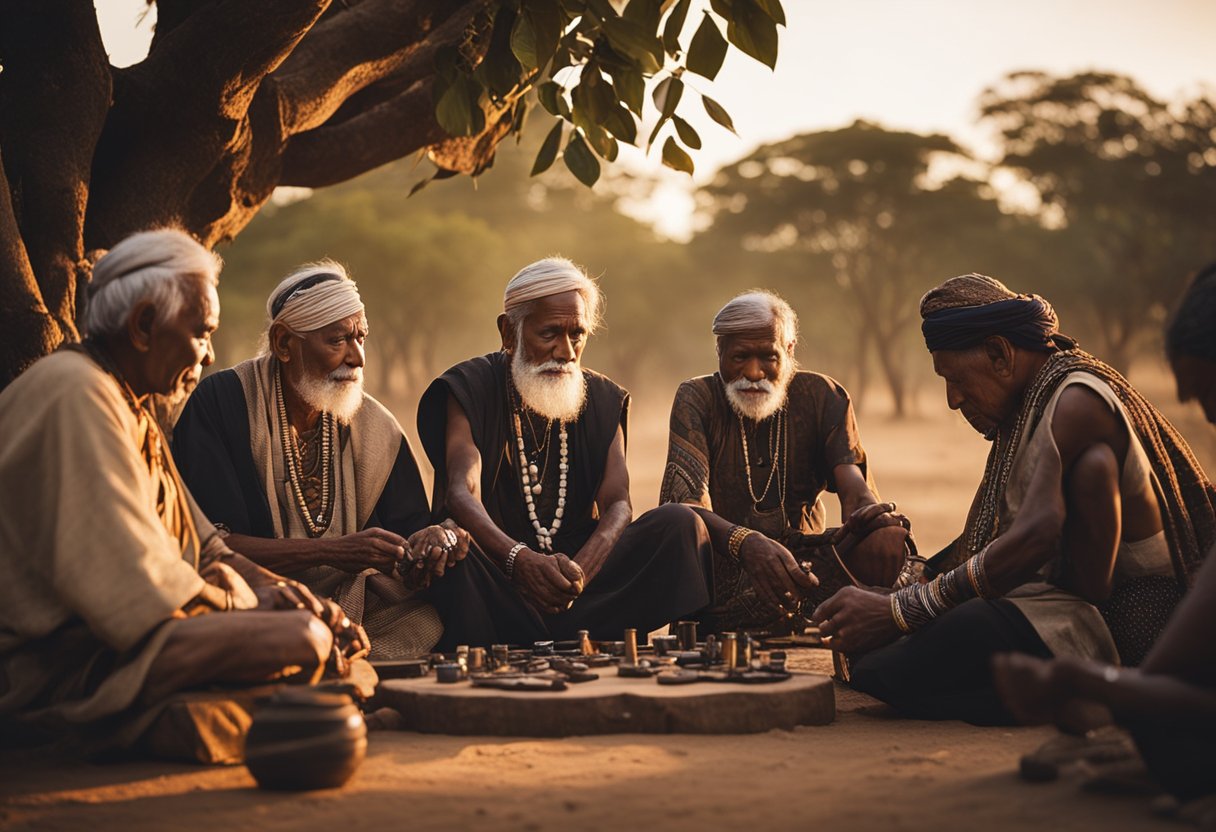
In our exploration of Pacific cultures, the preservation of traditional tattoo practices emerges as a testament to both identity and heritage. These methods are not merely artistic expressions but are imbued with deep significance within Polynesian culture.
Revival Movements
Throughout Polynesia, a revival of traditional tattooing is evident. This resurgence is more than a trend; it’s an act of reclaiming an important part of our heritage that was once suppressed but now thrives as a symbol of cultural pride and identity. Efforts from within the communities have been central to this renaissance, including practitioners mastering ancient techniques and scholars documenting the intricate meanings behind the symbols used.
Role of the Pacific Communities
The Pacific communities themselves are the custodians of this rejuvenation, ensuring the continuity of these practices into the future. By supporting the local tattooists who maintain the traditional methods of hand-tapping, we foster a living tradition deeply entwined with our social and spiritual fabric. It is through community engagement that the full gamut of tradition—from the significance of each mark to the ceremonies surrounding the tattooing process—continues to be part of our living heritage.
Frequently Asked Questions
In this section, we address some crucial queries regarding the intricate art of tribal tattoos within Pacific cultures. These tattoos are far more than mere aesthetics; they’re profound markers of identity, tradition, and personal history.
What is the significance of different Polynesian tattoo symbols?
Each Polynesian tattoo symbol encapsulates specific meanings that relate to the wearer’s identity, lineage, and social standing. These symbols often intertwine with natural elements and creatures, each carrying its interpretation, such as the turtle for longevity or the shark for protection.
Can you explain the meanings behind Polynesian tattoos that symbolise strength and courage?
Polynesian tattoos that represent strength and courage typically feature motifs like the spearhead, representing warrior prowess, and the sun, denoting leadership and fortitude. Wearing these designs signals a person’s valour and ability to face life’s challenges head-on.
Are there specific tattoos amongst the Polynesian tribes that hold a sacred status?
Certain Polynesian tattoos are considered sacred due to their association with spiritual or social significance. For instance, the Marquesan cross is a symbol deemed to harbour divine protection and cosmic harmony within the Marquesan community.
How do Samoan tattoo patterns differ in meaning from other Polynesian tattoos?
Samoan tattoo patterns, known as ‘Pe’a’ for men and ‘Malu’ for women, are distinctive for their intricate geometrical shapes, which often signify respect for tradition and strong connections to faith and community. These patterns differ from other Polynesian tattoos due to their unique designs and the specific social purposes they serve in Samoan culture.
Do Tongan tattoos carry unique meanings compared to the wider Polynesian tattoo tradition?
Tongan tattoos hold unique meanings that are deeply embedded in Tonga’s history and culture, such as the representation of social ranking and the rite of passage into adulthood. The symbols used can be starkly different from those found in other Polynesian tattoo traditions, embodying Tongan myths and local fauna.
In what ways do Polynesian tattoos narrate a person’s story or history?
Polynesian tattoos are essentially visual narratives etched into the skin, detailing a person’s lineage, achievements, and life experiences. For instance, specific patterns may denote ancestral ties or battles faced, providing an intimate insight into the wearer’s personal journey through life.






